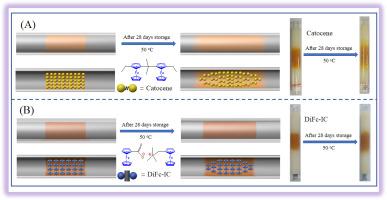双核二茂铁离子配合物作为高氯酸铵复合推进剂的高效燃速催化剂
IF 2.1
3区 化学
Q3 CHEMISTRY, INORGANIC & NUCLEAR
引用次数: 0
摘要
固体推进剂燃烧速率的精确控制对航空航天和国防应用至关重要。本文介绍了一种新型的双核二茂铁基离子配合物DiFc-IC,通过易离子自组装方法合成,作为高氯酸铵(AP)复合推进剂的高效燃速催化剂。采用1H-NMR、UV-Vis光谱和热重分析(TGA)对旨在减缓催化剂迁移的DiFc-IC进行了表征,确认了其结构、电子性能和热稳定性。对比TGA和差示扫描量热(DSC)分析表明,DiFc-IC显著降低了AP的高温分解(HTD)温度,与市售的catocene相比,表现出更好的催化活性。最佳DiFc-IC负载确定为5 wt%,产生AP分解动力学的显著增强。此外,迁移研究表明,与catocene相比,DiFc-IC在推进剂基体内的迁移明显减少,扩散系数约为catocene的7.6%。由于离子性质和推进剂粘合剂内更强的相互作用,这种增强的迁移阻力使DiFc-IC成为下一代固体推进剂配方的有前途的催化剂,提供了更好的性能和稳定性。本文章由计算机程序翻译,如有差异,请以英文原文为准。

A binuclear ferrocene-based ionic complex as a highly efficient burning rate catalyst for ammonium perchlorate composite propellants
Precise control of solid propellant burn rate is critical for aerospace and defense applications. This study introduces a novel binuclear ferrocene-based ionic complex, DiFc-IC, synthesized via a facile ionic self-assembly approach, as a highly efficient burning rate catalyst for ammonium perchlorate (AP) composite propellants. DiFc-IC, designed to mitigate catalyst migration, was characterized using 1H-NMR, UV-Vis spectroscopy, and thermogravimetric analysis (TGA), confirming its structure, electronic properties, and thermal stability. Comparative TGA and differential scanning calorimetry (DSC) analyses revealed that DiFc-IC significantly reduced the high-temperature decomposition (HTD) temperature of AP, exhibiting superior catalytic activity compared to the commercially available catocene. Optimal DiFc-IC loading was determined to be 5 wt%, yielding a substantial enhancement in AP decomposition kinetics. Furthermore, migration studies demonstrated that DiFc-IC exhibited significantly reduced migration within the propellant matrix compared to catocene, with a diffusion coefficient approximately 7.6% that of catocene. This enhanced migration resistance, attributed to the ionic nature and potential for stronger interactions within the propellant binder, positions DiFc-IC as a promising catalyst for next-generation solid propellant formulations, offering improved performance and stability.
求助全文
通过发布文献求助,成功后即可免费获取论文全文。
去求助
来源期刊

Journal of Organometallic Chemistry
化学-无机化学与核化学
CiteScore
4.40
自引率
8.70%
发文量
221
审稿时长
36 days
期刊介绍:
The Journal of Organometallic Chemistry targets original papers dealing with theoretical aspects, structural chemistry, synthesis, physical and chemical properties (including reaction mechanisms), and practical applications of organometallic compounds.
Organometallic compounds are defined as compounds that contain metal - carbon bonds. The term metal includes all alkali and alkaline earth metals, all transition metals and the lanthanides and actinides in the Periodic Table. Metalloids including the elements in Group 13 and the heavier members of the Groups 14 - 16 are also included. The term chemistry includes syntheses, characterizations and reaction chemistry of all such compounds. Research reports based on use of organometallic complexes in bioorganometallic chemistry, medicine, material sciences, homogeneous catalysis and energy conversion are also welcome.
The scope of the journal has been enlarged to encompass important research on organometallic complexes in bioorganometallic chemistry and material sciences, and of heavier main group elements in organometallic chemistry. The journal also publishes review articles, short communications and notes.
 求助内容:
求助内容: 应助结果提醒方式:
应助结果提醒方式:


